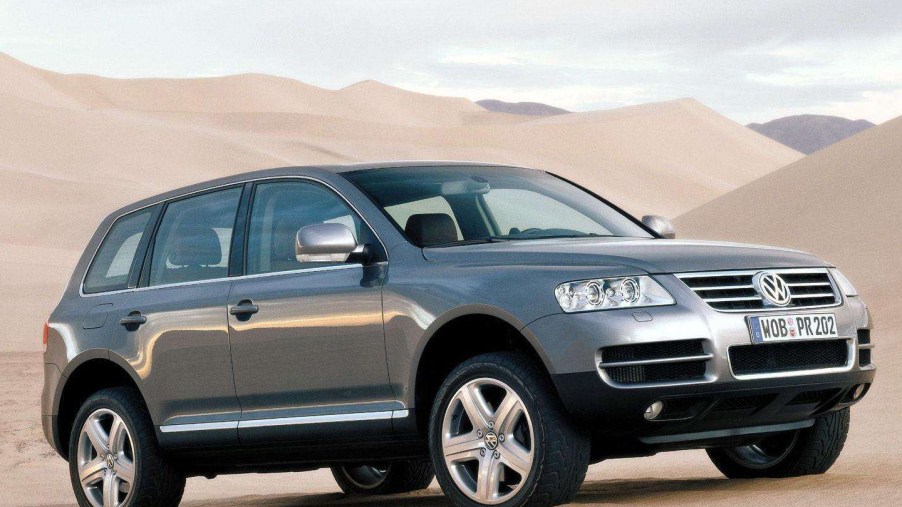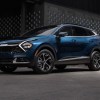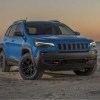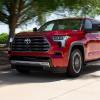
The Volkswagen Touareg Is Surprisingly Good Off-Road
Picture this: you’re happily crawling up an off-road trail in the Colorado Rockies in a luxury SUV. As you process that image, let’s suppose that the luxury SUV is a Volkswagen Touareg. So, how does a comfortable, tech-heavy mommy cruiser climb up a rugged 4X4 trail?
It does it surprisingly well. The Touareg, as The Fast Lane Car’s YouTube video proves, is a formidable off-roader, even when pitted against a doughty Land Rover Discovery of the same vintage. The differences become startlingly clear when they take on the popular Ironclads trail, located about an hour from Denver.
The Volkswagen Touareg
The 2004 Touareg in the video is just like any Touareg driven off the dealership lot 15 years ago: a stock version with no modifications whatsoever. It has normal tires, a unibody construction, and no skid plates. No other car seems so unprepared for the trail and receives so little regard among off-roaders than this one.
But hold on. Some key technology makes the Touareg offroad-worthy. For one thing, it has a real transfer case, automatic center and rear differential locks, and traction control. And these can be controlled by just turning a dial. Very few SUVs offered such sophistication at the time, as Tommy Mica points out in the video.
The VW’s four-wheel independent suspension system is another advantage, which gives it an astounding 11.81 inches of ground clearance. To get this height the driver chooses the offroad level of its four-corner air suspension. This system also provides onboard factory air for the Touareg’s tires—even the donut spare under the floor of the cargo area that probably wouldn’t help much on the trail.
Modern comfort and tech features aren’t top priorities for off-road enthusiasts. Nevertheless, the Touareg is loaded with them, from the infotainment screen to its four-zone climate control and five seat-position settings. Other goodies include automatic headlights with self-leveling projector beams and eight airbags.
The Touareg also brings power to the competition through a six-speed automatic transmission backed by a 4.2-liter V8 engine. It makes almost 100 hp more than the Land Rover.
The Land Rover Discovery
The 2004 Discovery has everything you’d expect a sturdy off-road vehicle to have: a ladder frame, coil springs, and solid axles. It’s equipped with a lift kit and oversize Goodyear Wrangler all-terrain tires. It’s protected by special bumpers front and rear, and it’s even kitted out with a recovery winch.
Inside, the Discovery holds to old-school luxury with leather-upholstered captain’s chairs and wood trim on the dash. The tech in the Discovery is bare-bones. It has a manual transfer case to shift in and out of low range. A simple lever controls the center differential lock.
The Land Rover uses halogen light bulbs in its analog headlights. And it has just two airbags. On the plus side, it has a full spare tire on the swing gate that is easy to access. There’s also an air compressor on board for tire inflation.
The 4.6-liter V8 engine is torquey enough, but the Discovery’s basic four-speed automatic transmission is lacking. As the video shows, the traction control system proves to be slow to respond.
How Do They Perform?
The Ironclads trail has three stages. The first stage of the trail is rocky, which requires both cars to stay in low gear. The Discovery capably steps through this part of the trail with some articulation. The Touareg performs differently from the Discovery, though, because of the way it distributes torque. Its traction control and automatic diff locks cause it to lift a wheel every so often instead of climbing over rocks like the Discovery.
The middle stage of the trail is more challenging for the Land Rover. Even with the low range selected and the center differential locked, the Land Rover still experiences wheel spin. Tommy Mica has to stay on the throttle until the Land Rover gets traction. This vehicle’s traction control sometimes struggles to distribute power to the wheels that need it.
By comparison, the Touareg hikes with more control through this stage, thanks to the off-road suspension with both differentials locked.
On the trail’s last stage, the Land Rover’s solid axles and coil springs support its reputation as a steadfast offroad vehicle. But the Volkswagen suffers a little from a tradeoff between the great ground clearance and the lack of articulation caused by its off-road suspension mode.
But the locking differentials do offset the stiff suspension and add traction. The regular tires create a small hang-up for the car’s traction but it’s not a showstopper. Overall, the Touareg holds its own on the trail and even excels in some of the more rugged sections.
Offroading Secrets of the Touareg
Although the Land Rover would be most people’s default choice for day-to-day offroading, the Touareg emerges as an excellent off-roader. But a little-known fact about the Touareg’s history of competing in off-road races supports this. Touaregs have run (and sometimes won) in the Baja 500, the Baja 1000, the Dakar Rally, and the Cape to Cape.
So, astonishing as it seems, the Touareg is a trail-ready contender. Just add some big all-terrain tires and better underbody protection, and you’ll be set to leave suburban streets behind!


